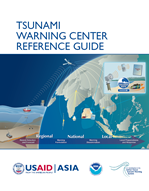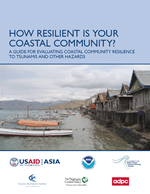
Tsunami Resources
Tsunami Warning Center Reference Guide
(USAID) This guide is a reference for countries that are establishing, maintaining, or enhancing tsunami warning centers as part of an overall tsunami warning system. It describes a concept of operations for a National Tsunami Warning Center (NTWC) or Regional Tsunami Watch Provider (RTWP) and provides outreach and education resources for these centers. The guide includes the key operational components of a tsunami warning center and the relationship of each component within an end-to-end tsunami warning system. Included are lessons learned by two NOAA operational tsunami warning centers in Alaska and Hawaii, as well as regional and national warning centers operated by France, Russia, and Japan. As a result, this document is a concept of operations (CONOPS) based on guidance established by the IOC. Those who will find the reference guide useful include International and national policy makers; National and local government preparedness officials; disaster responders, including nongovernmental organizations (NGO); television, radio, and newspaper reporters and editors; tsunami warning center staff members; and anyone who desires an understanding of Tsunami early warning systems.
Full Guide (PDF, 11MB)
- Individual Chapters (PDF)
- Chapter 1: Introduction to the Tsunami Warning Center Reference Guide (1.4MB)
- Chapter 2: Overview of a Tsunami Warning Center's Operational and Organizational Requirements (0.3MB)
- Chapter 3: Earth Data Observations (8.6MB)
- Chapter 4: Data and Information Collection (3.2MB)
- Chapter 5: Tsunami Detection (2.3MB)
- Chapter 6: Tsunami Warning Decision Support (1.7MB)
- Chapter 7: Warnings and Other Products (0.5MB)
- Chapter 8: Dissemination and Notification (4.2MB)
- Chapter 9: Community Connections (0.9MB)
Covers | Table of Contents | Citation
- The following summaries of key points drawn from the Tsunami Warning Center Reference Guide have been created for rapid review of the guide contents or to facilitate the creation of briefing and training materials.
- Local Decision Makers
- Emergency Managers
- NMHS Managers
- Tsunami Warning Center Staff
Specialized Reference Guide Summaries are available for:

Coastal Community Resilience Guide
(USAID) The Coastal Community Resilience (CCR) Guide was developed, building on lessons learned and experience gained in the Indian Ocean region after the 2004 tsunami, to address coastal hazards and reduce risk to vulnerable communities. The framework described in this CCR guide was developed in partnership with institutions throughout the Indian Ocean region, and is already beginning to guide development along Asian coasts most in need of building resilience. This guide attempts to broaden the perspective of sector plans so that a more holistic and robust planning framework evolves to truly elevate the potential for community resilience. The results of the CCR assessment process outlined in this guide can fit easily into and enhance development plans for any given coastal area, and can thereby complement traditional planning processes used by local and national governments.
Full Guide (PDF)
- Individual Chapters (PDF)
- Chapter 1: Introduction to the Coastal Community Resilience Guide
- Chapter 2: Why Are Communities at Risk from Coastal Hazards?
- Chapter 3: Why Is Resilience Critical to Coastal Communities?
- Chapter 4: What Are the Steps to Assess Coastal Community Resilience?
- Chapter 5: How Can Resilience Initiatives Be Sustained Over the Long Term?
- Chapter 6: Reference Guide to Resilience Elements and Benchmarks
- Appendix A: CCR Assessment Worksheets
- Appendix B: References and Resources
- Appendix C: CCR Assessment Training Course Session Guide
Covers | Table of Contents | Citation